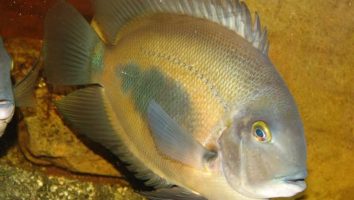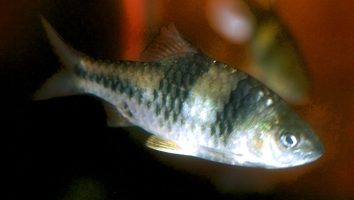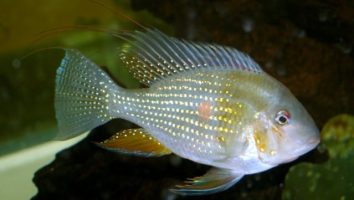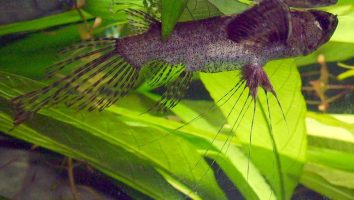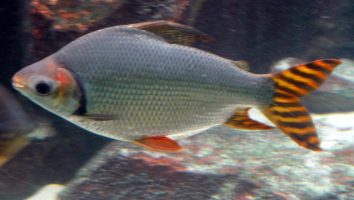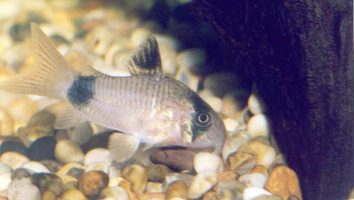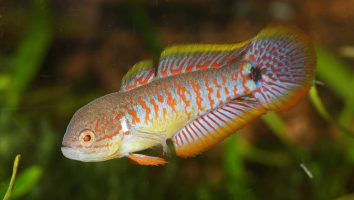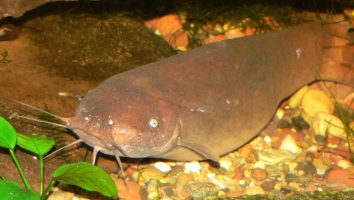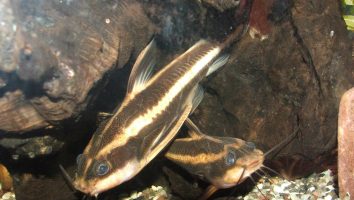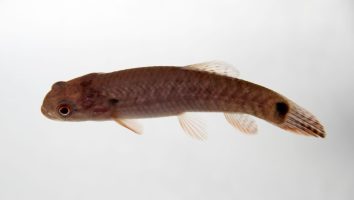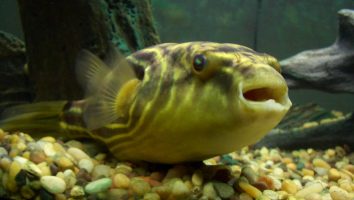The rainbow shiner is a beautiful freshwater fish that is perfect for beginners. They are very easy to care for and can adapt to a wide range of water conditions.
This guide will teach you everything you need to know about rainbow shiner care. You’ll learn about their diet, size, lifespan, and more!
Table of contents
Species overview
Rainbow shiners (Notropis chrosomus) are a freshwater fish that can be found in streams and rivers throughout the southeastern United States.
They prefer moving water with a moderate current and a sandy or gravel bottom. This is because they spend a lot of their time foraging for food near the bottom of the river.
Rainbow shiners are omnivorous, which means they will eat both plants and animals. In the wild, their diet consists mostly of insects, crustaceans, and small mollusks.
Rainbow shiners are a popular choice for aquariums because of their bright colors and their hardiness. They are also one of the few freshwater fish that can tolerate brackish water, which means they can be kept in tanks with saltwater fish.
Appearance
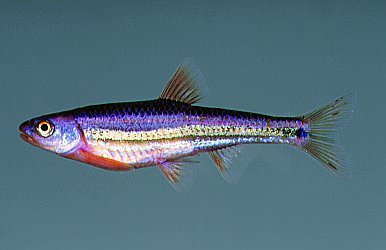
The first thing you’ll notice about this species is their coloration which is quite beautiful and eye-catching.
These fish have a silver sheen to their bodies with a few different colors running down the middle. The colors can be anything from pink to red to blue and everything in between.
Above their lateral line, you’ll find a beautiful rainbow hue. This is where they get their name from.
Their fins are all translucent and they have a moderate amount of them. They have a dorsal fin that starts a little more than halfway back on their bodies. This fin is tall and thin.
Their anal and pectoral fins are both on the smaller side. They have a forked caudal fin that’s tall and thin as well.
Rainbow shiners have a long and thin body shape that’s quite hydrodynamic. This helps them swim quite fast in short bursts.
Lifespan
The typical lifespan for a rainbow shiner is between 2 and 4 years. However, there are reports of these fish living up to 6 years in captivity.
As with most fish, the lifespan of a rainbow shiner is greatly impacted by the environment they’re kept in. Poor water quality, lack of food, or too much stress can all shorten their lifespan.
Size
The maximum size of a rainbow shiner is about 2.8 inches.
Tank
Tank Size
The recommended tank size for rainbow shiners is at least 30 gallons.
This is assuming you’re keeping them in a school of at least 5 or 6 fish (which you should).
We personally recommend a slightly larger tank if you can accommodate it. Every extra space will make a big difference and allow you to keep a larger school or more tank mates if you’re interested in a community tank.
Water Parameters
The rainbow shiner is a beautiful freshwater fish that’s perfect for the beginner aquarist. They’re hardy, adaptable, and relatively easy to care for.
One of the reasons they’re so easy to care for is that they’re not picky when it comes to water parameters. As long as the water is clean and the temperature is within their preferred range, they’ll do just fine.
Here are a few things to keep in mind when it comes to rainbow shiner care.
- Water temperature: 65 to 75 degrees Fahrenheit
- pH levels: 6.5 to 7.5
- Water hardness: 5 to 15 dGH
- Alkalinity Levels: 4-8 dKH
What To Put In Their Tank
The rainbow shiner is a freshwater fish that’s found in the southeastern United States. In the wild, they inhabit slow-moving rivers and streams with a sandy bottom.
When it comes to setting up an aquarium for these fish, you’ll want to replicate their natural habitat as much as possible.
The first thing you’ll need is a good quality aquarium filter. Rainbow shiners are known to be sensitive to water conditions and a stable environment is key to their health. A filter will help ensure that the water in their tank stays clean and free of harmful toxins.
For the substrate, we recommend using a sandy bottom. This will give them a place to dig and forage for food. It’s important to avoid using anything too sharp or abrasive since these fish are known to be delicate.
As for plants, you can include some if you wish. Just be sure to use species that are tolerant of slightly brackish water conditions. Hornwort and Java fern are two good options.
When it comes to decor, driftwood and rocks can be used to create some hiding spots for these fish. Just be sure that any rocks you use are smooth and free of any sharp edges.
Common Diseases
Rainbow shiners are a hardy and disease-resistant fish, but that doesn’t mean they can’t get sick. There are a few diseases that these fish are susceptible to, the most common being ich.
Ich is a very common parasite that can become quite serious if it’s not dealt with. The most obvious sign of this disease is the series of white spots that will begin to cover the body of your fish.
There are plenty of other potential diseases that can affect this species as well, but they’re not as common.
Another thing to look out for is infection from cuts. The most common cause of this is keeping your Rainbow Shiner in a tank with a rough substrate (or aggressive species that want to fight).
In general, the best way to prevent these fish from getting sick is to maintain the quality of the water in their tank. A tank with clean and stable water conditions always leads to healthier fish who are more resistant to disease.
Behavior & Temperament
The Rainbow shiner is a schooling fish, so it does best when it’s kept in groups. In the wild, these fish can be found in large schools of hundreds or even thousands of fish. So, when they’re kept in captivity, it’s important to try and recreate that environment as best as possible.
Rainbow shiners are relatively peaceful fish. They’re not known to be nippy or aggressive towards tank mates. However, they can be a bit skittish, so it’s important to have plenty of hiding places in their tank.
These fish are also known to be quite active. They’re constantly swimming around, exploring their environment. So, it’s important to have a tank that’s large enough to accommodate their needs. A 20-gallon tank is the minimum size you should go for.
Tank Mates
Tank mates for a rainbow shiner are limited.
This fish is on the small side and can easily be eaten by larger fish. As a result, you need to be careful when adding fish to the tank.
The best tank mates for a rainbow shiner are other small fish that occupy different parts of the water column. This way, the rainbow shiner can stay safe without feeling too cramped.
Some good rainbow shiner tank mates include:
- Cherry shrimp
- Ghost shrimp
- Neon tetras
- Ember tetras
- Cardinal tetras
- Rummy nose tetras
- Black neon tetras
- White cloud mountain minnows
Breeding
The first step to breeding these fish is to identify the males and females. The males have a more pronounced dorsal fin and are usually a bit larger than the females.
Once you’ve identified the sexes, you can start to set up a breeding tank. It should be at least 20 gallons and have a sandy bottom. The water should be between 75 and 80 degrees Fahrenheit.
To help with the spawning process, you can add some live plants and a piece of driftwood. The plants will give the female a place to lay her eggs and the driftwood will help to increase the water hardness.
When everything is ready, add two females for every male. The males will start to chase the females and nip at their fins. This is normal behavior.
Once the females are ready to lay their eggs, they will do so on the plants. The males will then fertilize them.
It’s important to remove the adults after the eggs have been laid. If you don’t, they will eat the eggs.
The eggs will hatch in about a week. When they do, you can start to feed the fry live baby brine shrimp.
Conclusion
The Rainbow Shiner is a beautiful freshwater fish that is perfect for beginner aquarists. They are easy to care for and are very peaceful, making them a great addition to any community tank.
Their bright colors will add some flare to your tank and they are very active, which many people enjoy.
If you’re looking for a low-maintenance fish that is still exciting to watch, the Rainbow Shiner is a great option for you!

